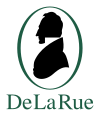De La Rue
 | |
| Company type | Public (LSE: DLAR) |
|---|---|
| ISIN | GB00B3DGH821 |
| Industry | Printing |
| Founded | 1821 |
| Headquarters | Basingstoke, UK |
Key people | Nicholas Brookes, Chairman James Hussey, CEO |
| Revenue | £753.6 million (2008) |
| £114.7 million (2008) | |
| £88.4 million (2008) | |
Number of employees | 2,311 (2022) |
| Website | www.delarue.com |
De La Rue plc (LSE: DLAR) is a British security printing, papermaking and cash handling systems company headquartered in Basingstoke, Hampshire. It also has a factory on the Team Valley Trading Estate, Gateshead. It is listed on the London Stock Exchange and is a constituent of the FTSE 250 Index.
History
The Company was founded by Thomas de la Rue who moved to London in 1821 and set up in business as a stationer and printer.[1] In 1831 his business secured a Royal Warrant to produce playing cards, in 1855 it started printing postage stamps and in 1860 it began printing banknotes.[1] In 1896, the family partnership was converted to a private company.[1]
In 1921, the de la Rue family sold their interests.[1] It was first listed on the London Stock Exchange in 1947.[1] The Company, then called Thomas De La Rue & Company, Limited, changed its name in 1958 to The De La Rue Company Limited.[1] A takeover bid for De La Rue was made by the Rank Organisation plc in 1968 but this was rejected by the Monopolies commission as being against the public interest.[2] In 1991 the company’s name was changed again - this time to De La Rue plc.[1]
In 2003 the Company acquired the banknote printing operations of the Bank of England.[3]

Operations
Banknotes
De La Rue sells high-security paper and printing technology for over 150 national currencies. They claim to be the largest such corporation in the world.
De la Rue makes paper and prints banknotes for many banks worldwide, including:
- Bank of England
- Monetary Authority of Singapore
- Central Bank of Kenya
- Bank of Tanzania
- The Royal Bank of Scotland
- Central Bank of Sri Lanka
- Bank of Scotland
- Isle of Man Government
- Reserve Bank of Fiji
- National Bank of the Republic of Macedonia
- Banco de Guatemala
- Central Bank of Iraq
- Central Bank of Bahrain
- Banco Central de Honduras
- Central Bank of Kuwait
Security printing and papermaking
De La Rue also produces a wide range of other secure documents, including:
Cash handling equipment
De La Rue manufactures a range of machines to manage cash including banknote counters, banknote sorters, coin sorters, ATM's and ticket dispensers. In September 2008, the majority of the cash handling division of De La Rue was the subject of a Carlyle Group-backed management buy-out (MBO) and renamed Talaris. Only the banknote sorter part of the business remained within the De La Rue group.
Other activities
De La Rue also produces holograms, as found on credit cards, banknotes and other secure documents.
Past products

Playing cards
In 1843 De La Rue established its first overseas trade, as de la Rue's brother Paul traveled to Russia to advise on the making of playing cards. Thomas de la Rue's designs for playing cards are the basis for the modern standard design. The playing card business was sold to John Waddington in 1969.

Postage stamps
The company has also printed postage stamps for Great Britain and some of its colonies. Some famous stamps such as the Cape of Good Hope triangulars were printed by De La Rue & Co. after Perkins Bacon fell out of grace with the postal authorities of the time. The first 50 years of postage stamp production were chronicled in John Easton's "The De La Rue History of British and Foreign Postage Stamps 1855-1901".
Writing instruments
De La Rue claims to have developed the first practical fountain pen in 1881. De La Rue was a leading manufacture of fountain pens in Britain. Products were marketed under the “Onoto” brand. Production of fountain pens by De La Rue ceased in Britain in 1958 but continued for a few more years in Australia.
